Korean Steamed Eggs (Gyeran Jjim)
Enjoy fluffy, velvety Korean steamed eggs, also known as Gyeran Jjim. This easy recipe combines eggs and chicken stock, steamed to perfection in a small pot for a delicious, melt-in-your-mouth side dish.
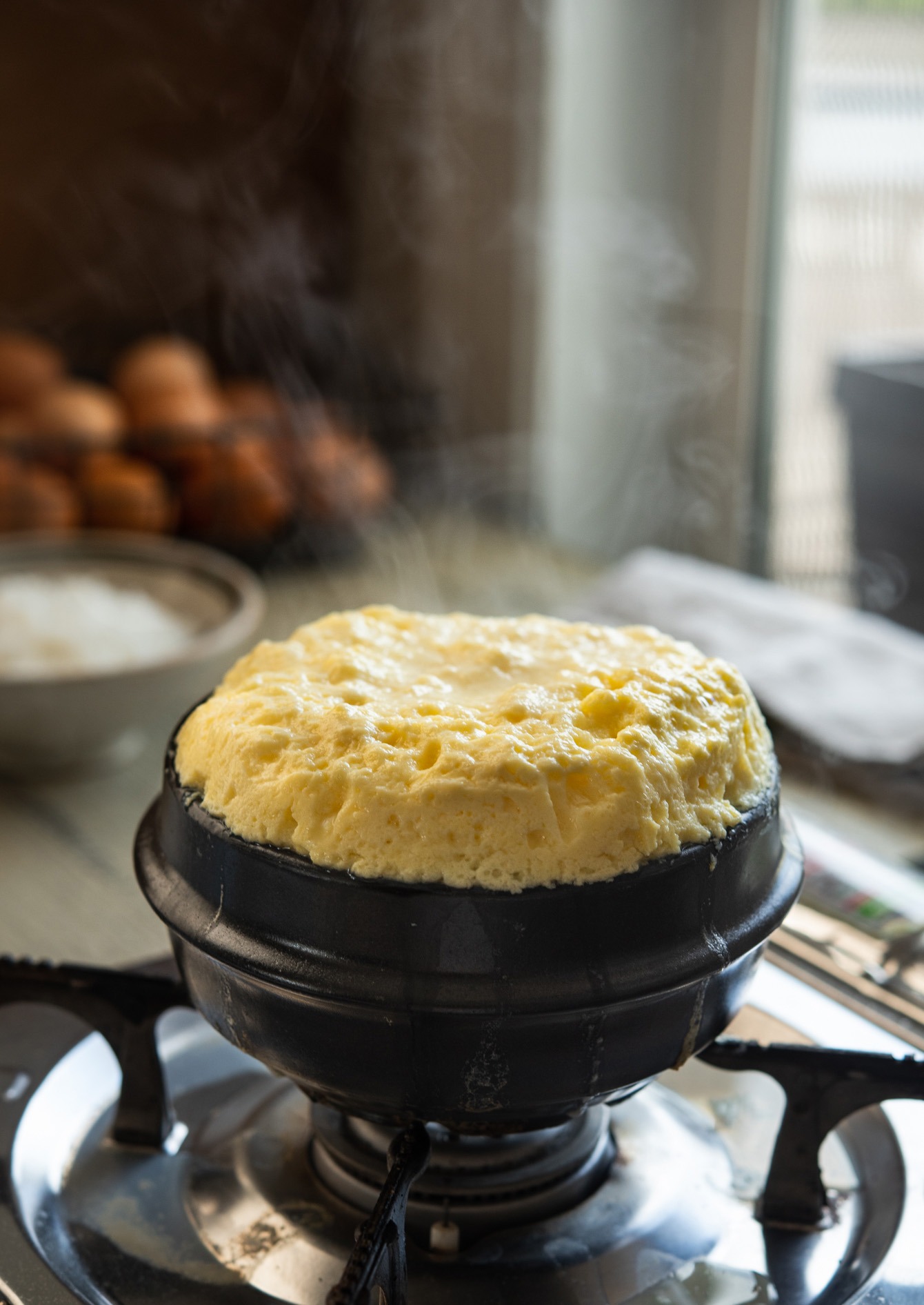
“No more scrambled eggs for the brush family, these eggs are the bomb! We served it with Thai dry curry and it was sublime.”
Brushjl
This Korean steamed egg dish almost looks like a volcanic egg soufflé ready to burst, doesn’t it? With this simple Korean recipe, you can easily make a popular side dish.
The velvety-soft consistency and silky texture of Gyeran-Jjim are irresistible. It’s no surprise that this dish is a popular choice at Korean BBQ restaurants, right alongside samgyupsal and other world-renowned Korean BBQ offerings.
What is Korean Steamed Eggs (Gyeran Jjim)?
Korean Steamed Egg, also known as Gyeran-Jjim, is a popular Korean side dish, or “banchan.” It goes by various names such as Korean Volcano Eggs or Korean Egg Bomb.
This dish involves whisking Eggs and combining them with a liquid like water or broth, then steaming the mixture in a traditional Korean stone pot. The result? A light, fluffy, and savory egg custard that erupts in a cloud of hot steam when you open the lid.
Although you can use water or even anchovy stock, I prefer chicken broth over anchovy broth to enhance the flavors—after all, eggs do come from chickens!
Think of this dish as a culinary experiment in Korean cuisine. People love making Gyeran-Jjim not just for its mouthwatering taste but also for the fun factor. It’s like conducting a no-mess science experiment right in your kitchen.
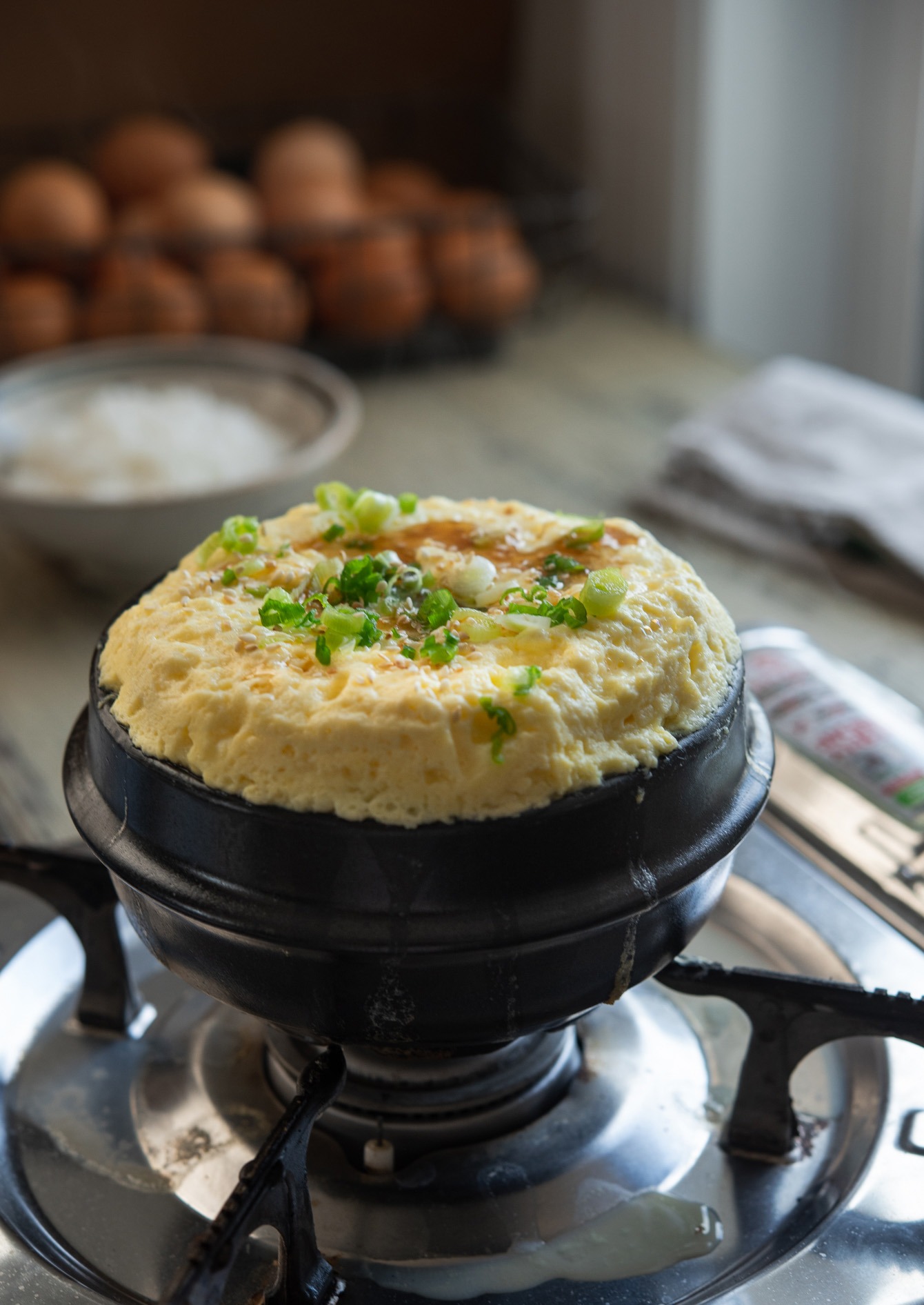
Korean Earthenware Pot (Ttukbaegi)
The Korean Earthenware Pot, commonly known as Ttukbaegi (뚝배기), is a versatile and traditional cooking vessel used in Korean cuisine. Made from clay, it’s designed to retain heat for an extended period, making it ideal for simmering stews, soups, and yes, steaming eggs for dishes like Gyeran-Jjim.
The Ttukbaegi adds a rustic touch to your meal while enhancing flavors and keeping your food hot for longer. If you’re looking to bring authentic Korean cooking into your kitchen, a Ttukbaegi is an essential piece of equipment to have.
I use a Ttukbaegi for my Doenjang Jjigae recipe, which is a Korean soybean paste stew, to achieve authentic Korean flavors and cooking techniques.
Expert Tips
These expert tips will guide you through this easy Korean recipe, ensuring you get the fluffiest, most flavorful steamed eggs every time.
- Choose the Right Pot: Traditional Korean earthenware pots are best for heat retention and steaming. However, any small heavy bottom pot with about 1/2 quart volume will do the trick.
- Whisk Eggs Well: Use a small whisk to beat the eggs until smooth. This ensures a soft, velvety texture.
- Coat the Pot with Sesame Oil: This will prevent the eggs from being baked onto the pot, making the cleanup easier. It also adds extra aroma.
- Constant Stirring: Continue stirring until roughly 80% of the egg mixture turns curd-like. Then, cover the pot with a heat-safe dome-shaped bowl.
- Egg-to-Stock Ratio: A personal preference. More eggs make the dish hold its shape longer but give it a heavier texture. More stock will make it lighter but less stable and cause a quicker deflation.
Ingredients and Equipment You’ll Need
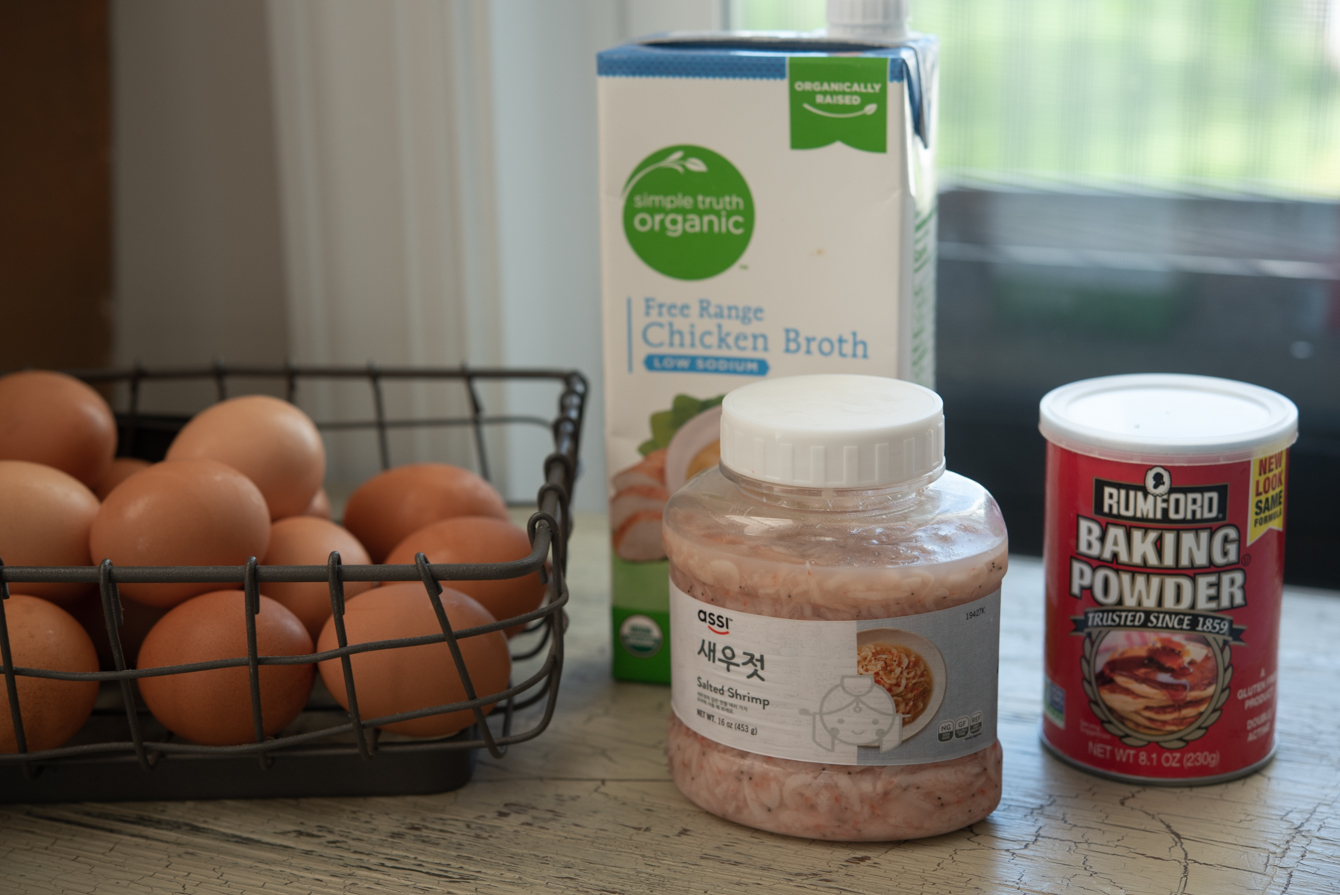
- Small Pot: Opt for a 1/2-quart small earthenware pot or other pot to ensure the dish cooks evenly.
- Dome-Shaped Heatproof Bowl: Use this to cover the pot and trap steam for a fluffier texture.
- Eggs: These are the star of the dish, so fresh ones or are best. Opt of organic, free-range eggs for the best result.
- Chicken Stock: Choose a quality stock to enhance the flavor and give the eggs a silky texture.
- Baking Powder: A little goes a long way to help your eggs rise to their fullest potential.
Optional Ingredients:
- Salted Shrimp (Optional): Include this for an added umami flavor. More authentic Korean flavor boost!
- Chopped Green Onions: Green onions enhance the egg dish with their fresh, sharp taste.
- Sesame Oil and Sesame Seeds: These add a delightful nutty aroma and flavor, making a scrumptious finish touch.
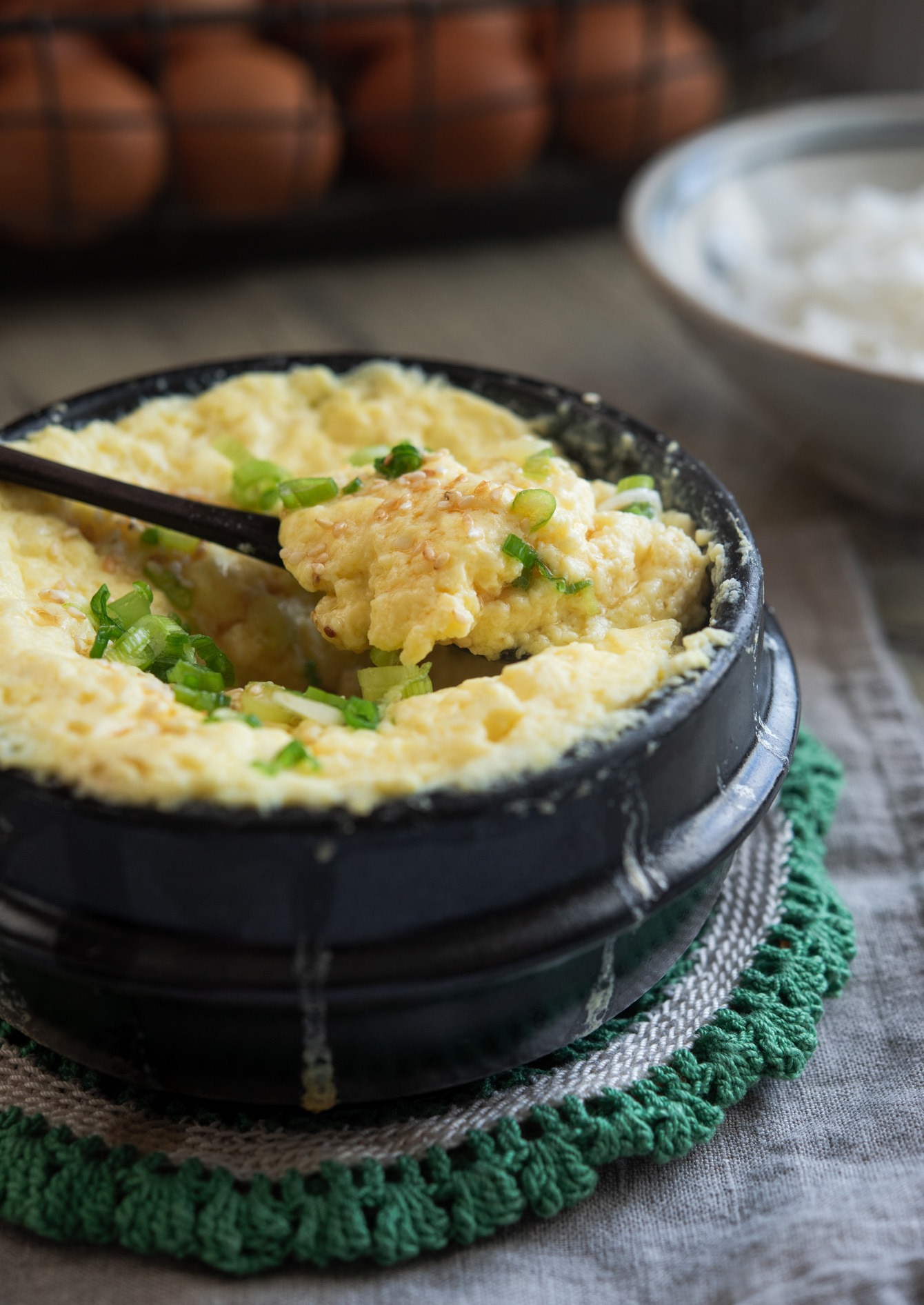
FAQs
What if you don’t have an earthenware pot?
You can still make the dish without an earthenware pot. Just follow the original steps, and extend the steaming time by 2-3 minutes to ensure the eggs are fully set.
What if I have to use a bigger pot than 1/2 quart ?
Aim for a 1:1 ratio of eggs to chicken stock. The total volume should be close to your pot’s capacity. If your pot holds 3 cups, use 1.5 cups each of eggs and chicken stock. Feel free to add an extra egg to fill the pot to about 90% of its capacity.
How do you keep the eggs from deflating?
To maintain the fluffy texture, use a higher ratio of eggs to stock. This will result in a denser but longer-lasting puffiness.
How to Make Korean Steamed Eggs: Step-by-Step Instructions
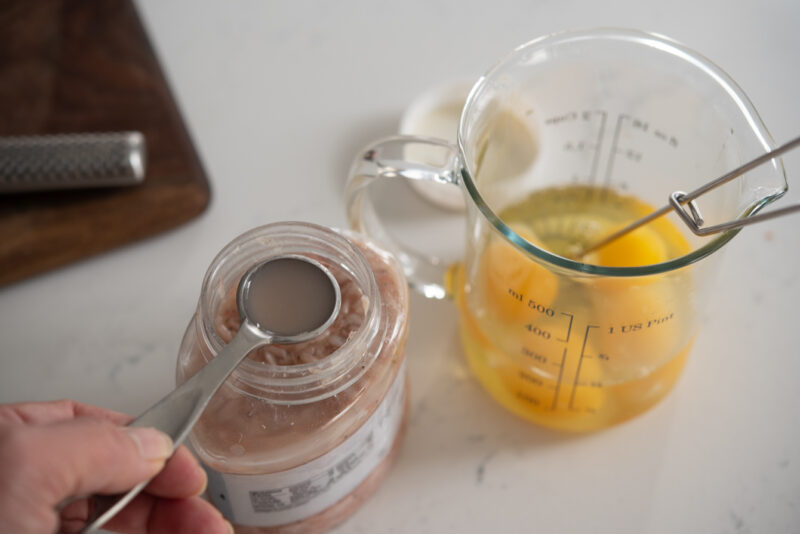
Step 1. Combine eggs, salted shrimp (if using), and a pinch of salt in a medium mixing bowl.
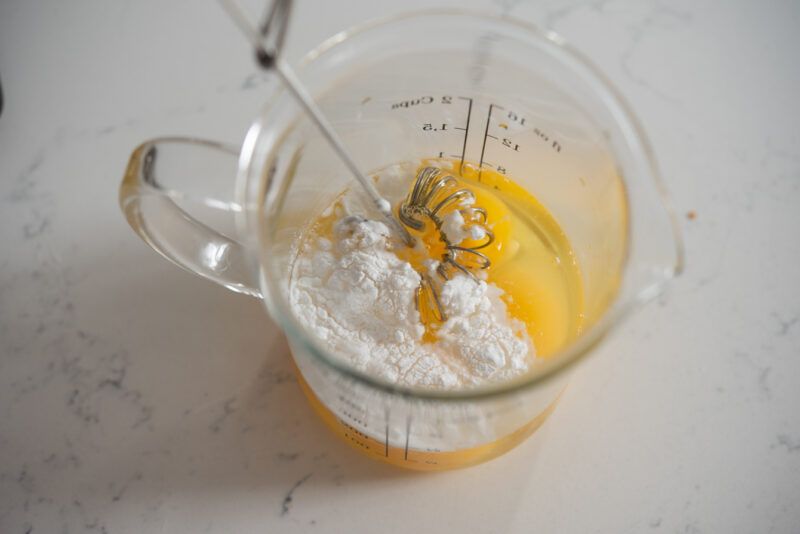
Step 2. Add baking powder and beat them well until frosty.
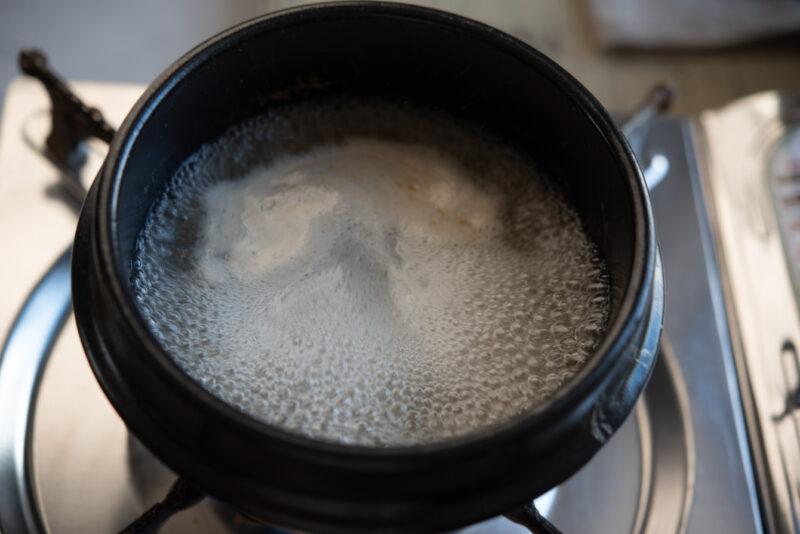
Step 3. Pour chicken stock in a pot and bring it to boil over medium high heat.
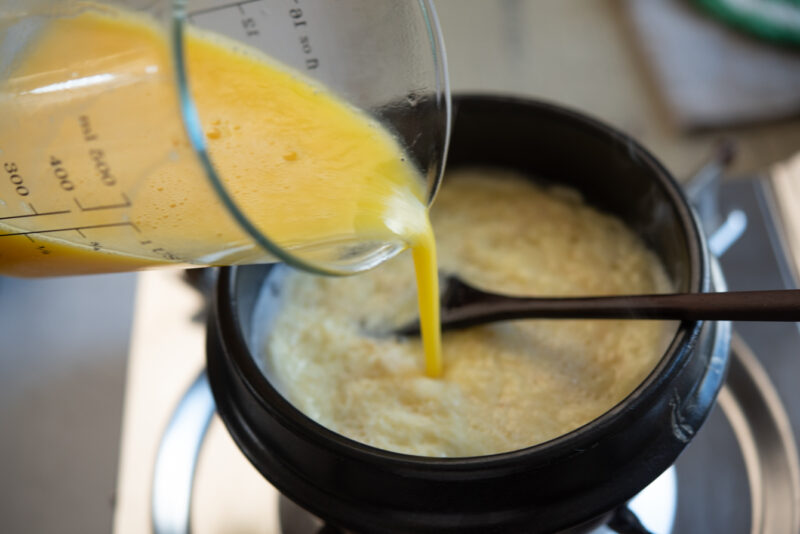
Step 4. Reduce the heat to medium. Slowly pour egg mixture into the chicken stock as you stir gently with a spoon.
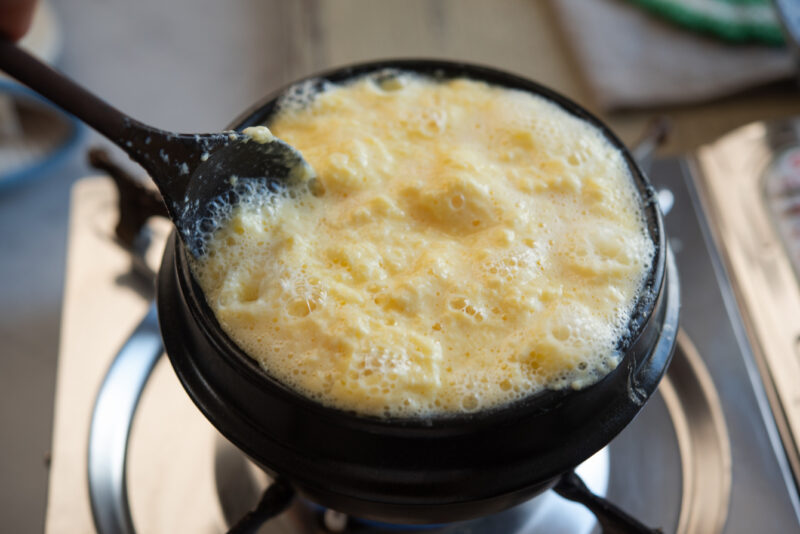
Step 5. Keep stirring the egg mixture, scraping it as necessary from the side of the pot to the center. You will want to stir until the egg mixture reaches 80% cooked, about 2 minutes.
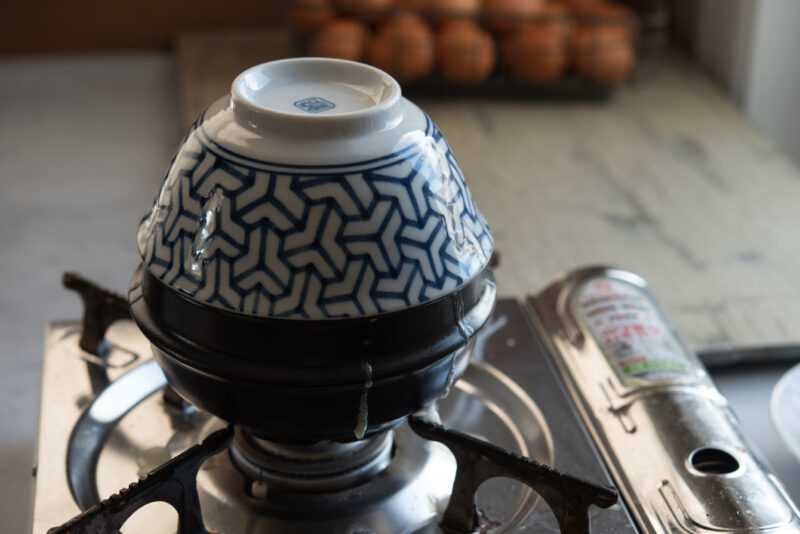
Step 6. Cover the pot with a dome shaped heat-safe bowl immediately. Reduce the heat to low and let it simmer for 2-3 minutes.
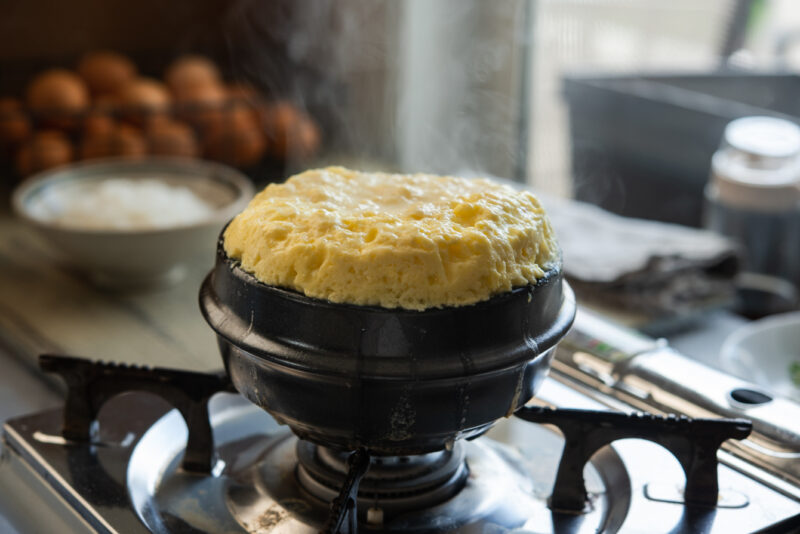
Step 7. Turn off the heat and remove the lid (make sure to wear kitchen gloves). You will see the egg mixture has risen well above the rim of your pot.
Serving Suggestions
Garnish your fluffy Korean steamed eggs with a sprinkle of chopped green onions, sesame seeds, and a light drizzle of sesame oil. Serve hot with a bowl of Korean rice, your preferred main dish, and some kimchi for a complete Korean meal.
Keep in mind that the eggs may deflate if left to sit for too long. To maintain the dish’s fluffy texture, use more eggs and less chicken stock. This will result in a denser but longer-lasting puffiness.
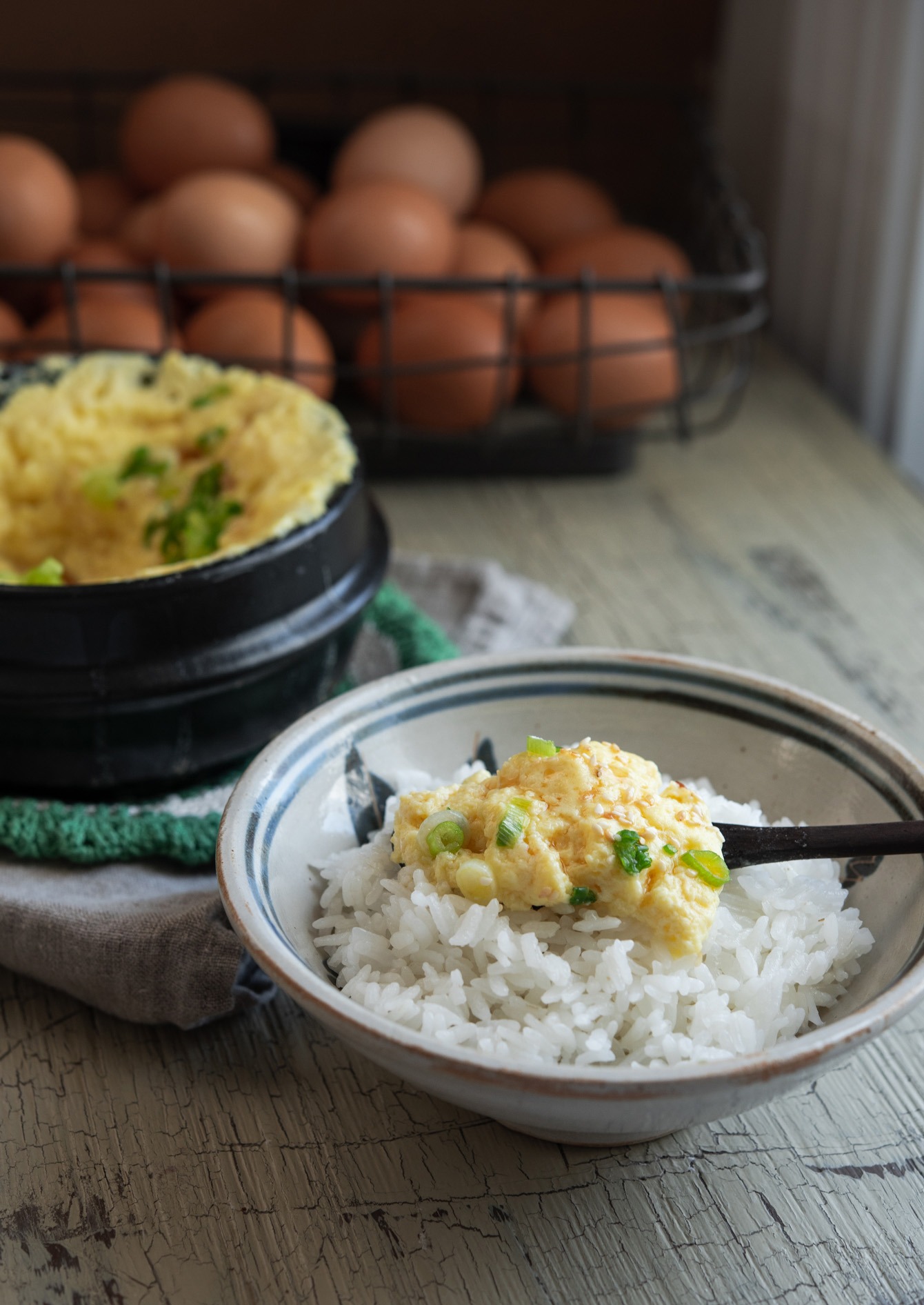
More Egg Dishes
- Egg Fried Rice Recipe
- Gyeran Bap
- Spicy Tofu and Egg in a Skillet
- Tofu and Egg Pudding in Microwave
- Tofu with Egg and Tomato
Love this recipe? Rate it and share your experience in the comments below! On Instagram? Tag me to showcase your creation. For more delicious recipes, subscribe to our newsletter!
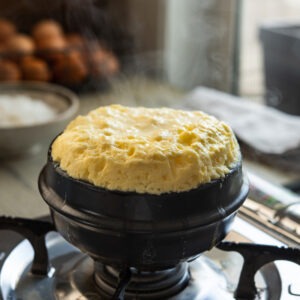
Korean Steamed Eggs (Gyeran Jjim)
Recipe Video
Ingredients
- 6 large eggs, well beaten
- 1 cup (240 ml) chicken stock
- 1 tsp Korean salted shrimp , liquid only, optional
- 2 pinches kosher salt
- 1 tsp baking powder
- 2 tsp sesame oil, optional
- 1 tbsp finely chopped green onion, optional
Equipment
Instructions
- Combine eggs, salted shrimp (if using), and a pinch of salt in a medium mixing bowl. Add baking powder and beat them well until frosty.
- Pour chicken stock in a pot and bring it to boil over medium high heat. Reduce the heat to medium. Slowly pour egg mixture into the chicken stock as you stir gently with a spoon.
- Keep stirring the egg mixture, scraping it as necessary from the side of the pot to the center. You will want to stir until the egg mixture reaches 80% cooked, about 2 minutes.
- Cover the pot with a dome shaped heat-safe bowl immediately. Reduce the heat to low and let it simmer for 2-3 minutes.
- Turn off the heat and remove the lid (make sure to wear kitchen gloves). You will see the egg mixture has risen well above the rim of your pot.

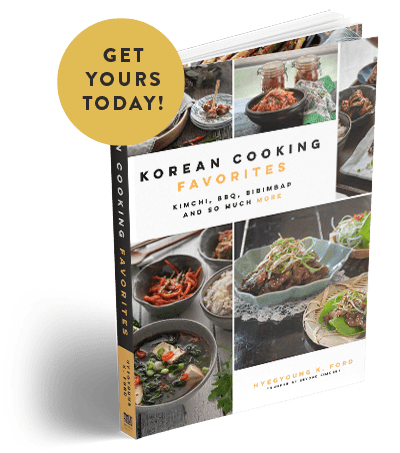
Is it normal to have a bit of broth pooling around the edges or my eggs are too small?
It’s perfectly normal to see a little bit of broth pooling around the edges. If you broth sitting on top of eggs after cooked, then it’s a sign that too much of liquid is added.
Thank you Holly! I will decrease the broth next time.
No more scrambled eggs for the brush family, these eggs are the bomb! We served it with Thai dry curry and it was sublime.
Looks delicious and easy enough!! What type of bowl do you recommend to use and how would you do it so that clean up is easy? I use a glass bowl and the egg pudding after cooking left a permanent stain on the bowl!! Thanks!
This is my fave side dish! Whenever we go to our favorite korean bbq place, we always get a side order of the steamed egg. I have tried making this before, but could not get the taste right. Thank you!
thank you Holly for the suggestion…i’ll try it
Hai..
I’m really craving for Korean food everytime i saw them. For the first timer to try the korean food, what do you suggest me to taste first. because i think korean food very different from Malaysian cuisine right ^__^
This particular egg pudding recipe is very simple side dish to try first. Also Try easy Korean beef recipe in my site. You can find it under recipes tab on my menu bar on top.
Been missing this from my childhood. Thank you so much.
Hello there, I’m your new visitor to your blog (just recently discovered it this morning when I was trying to find a Kimchi recipe). I’m so happy to find this dish here. Almost 6 years ago, I went to Korea as an exchange student and met my husband there. In our first date in Daejeon, we had this steamed egg pudding at a street vendor. At that time we couldn’t order anything except for this dish and a bottle of soju because we didn’t speak any Korean. Thus, this entry brings back so many precious memories for us. I will make this tomorrow. Thank you so much, Holly 🙂
Hi Jessica, I am so glad to hear that it turned out so well for you. Sometimes, creating a good dish is not just coming from a good recipe, it is about knowing good tectonics and know-hows to make it better. Simple tips help things go much smoother in cooking.
Thank you for your support.
Holly~ This is my Korean hubby's favorite dish, but I've never been able to get it quite right. No other recipe talked about using a dish to stabilize the pot, or covering the pot with foil. Those must've been the missing parts for me, because the keran turned out so well! I loved using chicken broth as well…it was very tasty and I used salt instead of the shrimp. 🙂 Thanks for your labor of love in this blog. 🙂
Thanks Holly, I already had in mind to buy the anchovies and kelp. I will most likely also get the others recommended. I recently tried fresh roasted seaweed from Korea, my bf's uncle's gf is korean and her family own a seaweed factory – it's so good with rice!
Thanks, Lucy. I am glad that it turned out good for you.
Stock up lots of stuff from Korea. I would recommend Korean chili flakes, dried Korean anchovies, dried seaweed for roasting, and home-made doenjang if you can handle. These are the stuff I usually get when I go to Korea.
Holly, I tried this recipe last night, and it was SOOO good! I love the velvety texture of the egg, and the best part was it took less than 5 mins to assemble and I had a great dish! My boyfriend absolutely loved it, and polished it all off along with the left over kimcheese mixture we had left over from the night before! =)
*A big thumbs up* for all the dishes we have tried on your blog so far! will be trying more especially once we go korea and stock up for my kitchen!
Thanks, Jeanene.
I hope you are doing well with your family.